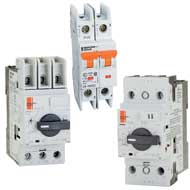Literature
Technical Tips & FAQs
How to specify a 2-pole, 240 VAC, 15 Amp, Motor Circuit Breaker
Questions: When specifying a 2-pole, 240 VAC, 15 Amp, Motor Circuit Breaker what product should be proposed? Why does KTU7 literature say for non-motor loads? Why canít you use KTU7 on a motor load?
Answers:
- One could select the L9-15/2/D which is a UL489 Molded Case Circuit Breaker, 14 KAIC, and less expensive than KTU7
- One could use a KTU7-D-2D-15 which is a UL489 Molded Case Circuit Breaker, 65 KAIC, 100% rated or you could use a KTU7-2D-12 because at 15 amps or less KTU7 is 100% rated
- One could use a KTA7-25S-16A which is a UL508 Type E Self-Protected Combination Motor Controller, 30 KAIC and less expensive than KTU7 or you could use a KTA7-25H-16A to achieve 65 KAIC
You can use option 1 or 2 to meet the above specification which complies with NEC430-52 Option 1; if this were the only consideration and price is an issue then a miniature circuit breaker is sufficient, but this isnít the only consideration that should be made.
Options 1 and 2 provide short-circuit protection from the branch circuit; but this does not comply with the requirement for an overload relay to protect the motor from overload per NEC430-32. This means the customer must still purchase an overload relay. Some people are under the impression that since a UL489 circuit breaker is a thermal-magnetic device that it also operates as an overload relay. This is incorrect! No device like Option 1 or 2 or a straight 600 V molded case circuit breaker (MCCB) or a motor circuit protector (MCP) or high interrupting motor circuit protector (HMCP) complies with NEC code and UL requirements for an overload.
Option 3 is a UL508 Type E Self-Protected Combination Motor Controller and therefore complies with the requirement for short-circuit protection for the branch under NEC430-52 Option 6 and complies with NEC430-32 for a UL approved overload relay and has the following advantages:
- KTA7 motor controllers have a lower cost than an L9 + overload relay and lower cost than KTU7. Further, a KTU7 still needs an overload for a motor load
- KTA7 has a higher KAIC rating than L9 miniature circuit breakers
- KTA7 has an adjustable FLA dial and L9 and KTU7 have fixed thermal protection
- L9 breakers do not have a door operated disconnect mechanism and KTA7 does (so does KTU7 for that matter)
Yes, you could use a KTU7 breaker on motor loads as it is a UL 489 approved circuit breaker but why would you? Consider the advantages of KTA7. We say KTU7 is for non-motor loads because KTA7 is a Self- Protected Motor Circuit Controller (operative word is Motor). KTA7 is not approved for non-motor loads and KTU7 is.
Categories: Motor Circuit Controllers, Circuit Protection
1661

